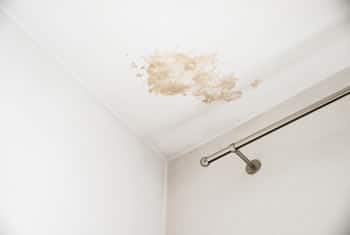 No one likes ugly brown spots on ceiling or walls. It looks hideous and also spoils the décor of your house. But there has to be a reason why you are getting these spots in the first place.
No one likes ugly brown spots on ceiling or walls. It looks hideous and also spoils the décor of your house. But there has to be a reason why you are getting these spots in the first place.
Brownish stains are a common occurrence and are caused due to two main reasons. The good news is both the issues can be fixed with the right approach.
One of the main causes of brownish stains on the ceiling is water damage. This may occur due to leaky pipes, roofs, or water from other sources.
When leaking water seeps through building material and reaches the gypsum-based drywall ceiling, it causes discoloration. The ceiling will eventually dry out, but the stains will remain. Another valid cause is mold damage.
If there is excess moisture or your ceiling stays damp for a long time, it can lead to the formation of a yellowish-brown stain. This will remain as it is unless you do something about it.
Brown stains caused by water damage are not harmful to your health. But mold growth poses a potential risk to your health, especially if you are an allergic person.
But both the causes can be fixed with the right solution. In this guide, I will discuss how to remove brown spots on ceiling.
What causes brown spots on ceiling?
Before you start fixing the problem, you need to first identify what’s causing it. In this section, I will try to answer the most common questions you need to know.
Brownish stains on the ceiling can occur due to water damage, which can result from plenty of things. Some of the causes are:
- Vents or skylights that are vulnerable to leaks
- Improper installation of HVAC units
- Leaking pipes
- Damaged waterproofing membrane
- Roof failure
Brown Spots On Bathroom Ceiling
A bathroom is a place that remains damp most of the time. If you notice brown spots on bathroom ceiling, it could be the result of excess dampness. If there is a water leak somewhere near the spots, it can leave brownish spots. The stains will stay even after the water dries out.
But in some cases, the brown spots can occur due to mold growth. If the stains appear to be a little green or yellowish, chances are you have mold in that area. When it grows, it becomes darker and more dangerous over time. This should be fixed immediately, or else you may have health issues.
How to avoid brown spots on ceiling in bathroom?
In this section, I will tell you how to avoid brown spots on ceiling in bathroom. Follow each of the steps and you should be able to fix the problem in no time.
Solution For Water Damage
If the stains are caused by water damage, you need to do the following:
- Prepare a mixture of bleach and water and apply it to the stained area.
- Let it stay for some time and wipe it away.
- After the area dries, apply a fresh coat of paint over the area.
- Remove or repair the damaged part of the ceiling.
- Also, fix the water problem that caused the stains in the first place.
If you have mold damage, call a remediation service to take care of it. They will use special techniques to remove and prevent mold in the bathroom ceiling.
If you are doing it yourself, use a bleach/water mix to kill it. Now that you know how to clean brown spots on bathroom ceiling, you should be able to do it properly.
Brown Spots On Ceiling Paint
So, you have recently painted your ceiling and you can already notice brown spots on ceiling paint. This is no doubt annoying, but most importantly you have to identify the reason that’s causing it.
If you notice these spots after painting, it is most likely caused due to water damage. You should check the areas close to the stains for any pipe leaks, roof failure, or other sources of water. Once you locate the source of water causing the problem, you can fix it by hiring a contractor.
To remove the stains, you should clean the area with a mix of bleach and water. I have already explained the steps in the previous section.
Another possible reason behind the stains could be mold damage. This is a serious issue and should be taken care of immediately. If you let the mold grow, it will turn dangerous for your health. In this case, you need the help of a mold remediation service.
Brown spotting on the ceiling can also result from ghosting. This happens due to the accumulation of dirt, soot, and dust particles on your ceiling. If you leave it for a long time without cleaning, it will form brownish stains.
Small Brown Spots On Ceiling
 Do you notice small brown spots on ceiling? The main reason behind this could be water build-up.
Do you notice small brown spots on ceiling? The main reason behind this could be water build-up.
Your first goal should be to identify the water source that causing the stains. It could be a leaky pipe, roof, or any other water source like run-off water from the bathroom.
You should look for water damage near the spots. This will help you to find out the problem sooner.
If you have leaky pipes around the house, it could cause water to drip long the beams or rafters inside the home. But if the water stains are from a leaky roof, it needs further assessment. For this, you should hire a professional roofer, so that he can inspect the damage and fix it.
Brown water marks on ceiling look ugly. It is better to get rid of them sooner, or else it’s only going to worsen the problem.
Dry Brown Stain On Ceiling
There could be several reasons that cause a dry brown stain on ceiling. Before you try to fix it, you need to identify the root cause of the problem, so that you can prevent it from happening in the future.
Brown spots, or patches, on your ceiling and upper walls are mainly caused by water damage from a leak above. This leak could be a leak in any of the pipes, HVAC units, or an issue with your roof system.
- HVAC Units
HVAC units can cause water stains in the following cases:
- Improper installation
- Water leaking from the unit
Instead of trying to fix it yourself, you should contact your HVAC contractor. They will inspect the problem and fix it for you.
- Leaking Pipe
Leaking pipes in walls and ceilings can slowly drip water until it forms a stain. Pipes get damaged over time and therefore, should be repaired or replaced from time to time.
- Roof Flashing Failure
Flashings are metal pieces that are installed on a roof to join two areas together. It is used to prevent water from leaking through vulnerable areas. If the flashings fail, water may start to leak through your roof, and form a stain on the walls.
- Damaged Waterproofing Membrane
If the waterproofing membrane of your building is old or damaged, it will fail to stop water from leaking. If you ignore it for a long time, it can form a brown stain on ceiling.
How to get rid of brown water stains on ceiling?
By now you know the main reasons for brown spots on the ceiling. In this section, I will tell you how to get rid of brown water stains on ceiling. If you are facing anything of this sort at home, you should follow the steps given below.
- Your first step is to identify the problem that’s causing the water stains on the ceiling. If there is any leak, you need to get it fixed by a contractor. If the problem is caused by your HVAC unit, contact your HVAC contractor.
- To remove the stains, use a solution of bleach and water.
- Apply it to the affected area and let it sit for at least 10 to 15 minutes.
- After that rinse off the area. You may have to repeat this step a few times until the stain is completely gone.
- Once the area is dry, apply a coat of stain block primer.
Q&A
Are brown spots on ceiling mold?
If the brown spots look fussy and velvety, it is mold. When mold grows older, it turns dark.
How do I get dark spots off my ceiling?
You should use a solution of bleach and water to remove dark spots from the ceiling. Let the solution sit for some time before wiping it off.
Can you just paint over water damage?
Yes, you can as long as the drywall is not weak. But you should get a professional to get this done.
What do water spots on the ceiling mean?
Water stains on the ceiling mean there is a leak above. This could be a leaky pipe, failed waterproof membrane, leaky HVAC unit, or roof failure.
Conclusion
Brown spots on ceiling can be caused due to water damage or mold growth. No matter, what the cause is, you should take the necessary steps to fix it. Ignoring it for long can damage the look of your house and décor.
